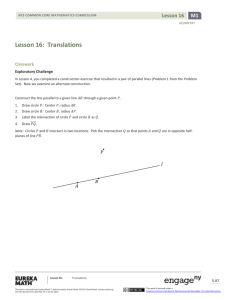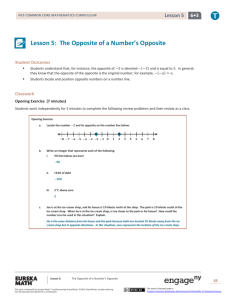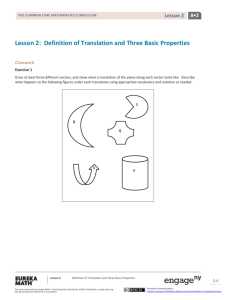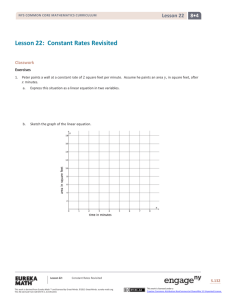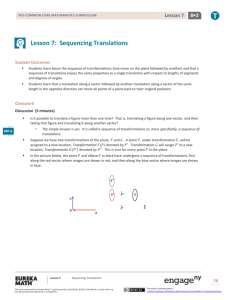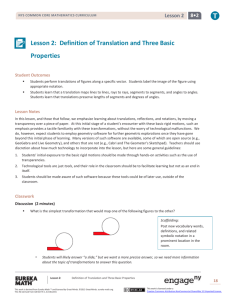Lesson 16: Translations
advertisement
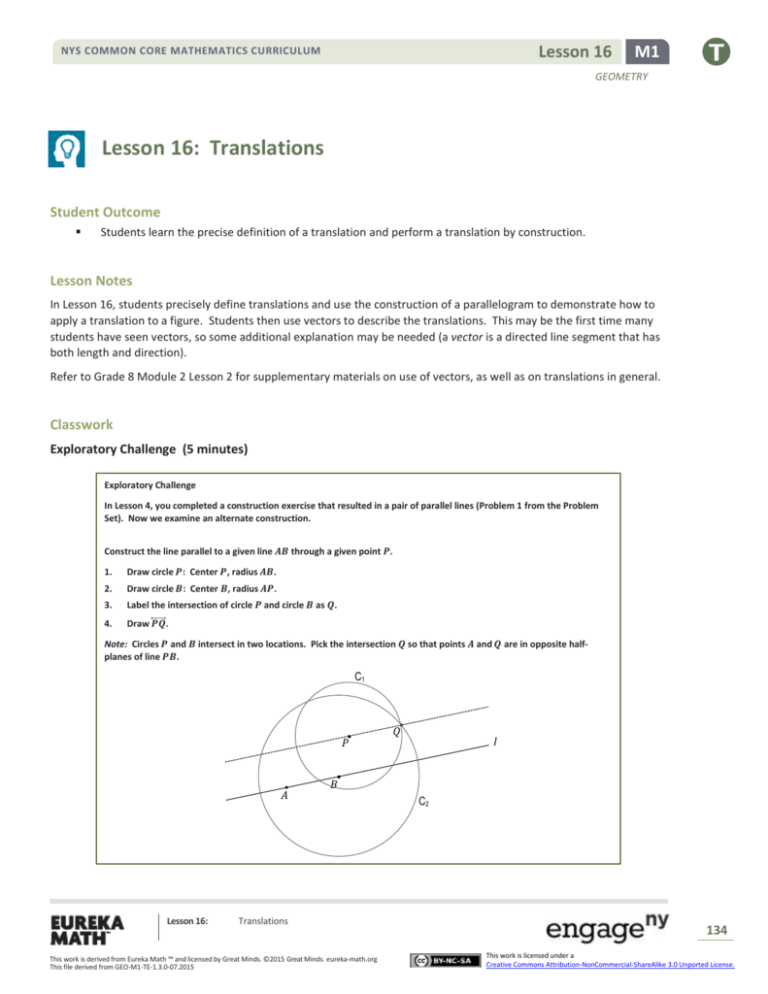
Lesson 16 NYS COMMON CORE MATHEMATICS CURRICULUM M1 GEOMETRY Lesson 16: Translations Student Outcome Students learn the precise definition of a translation and perform a translation by construction. Lesson Notes In Lesson 16, students precisely define translations and use the construction of a parallelogram to demonstrate how to apply a translation to a figure. Students then use vectors to describe the translations. This may be the first time many students have seen vectors, so some additional explanation may be needed (a vector is a directed line segment that has both length and direction). Refer to Grade 8 Module 2 Lesson 2 for supplementary materials on use of vectors, as well as on translations in general. Classwork Exploratory Challenge (5 minutes) Exploratory Challenge In Lesson 4, you completed a construction exercise that resulted in a pair of parallel lines (Problem 1 from the Problem Set). Now we examine an alternate construction. Construct the line parallel to a given line 𝑨𝑩 through a given point 𝑷. 1. Draw circle 𝑷: Center 𝑷, radius 𝑨𝑩. 2. Draw circle 𝑩: Center 𝑩, radius 𝑨𝑷. 3. Label the intersection of circle 𝑷 and circle 𝑩 as 𝑸. 4. ⃡ . Draw 𝑷𝑸 Note: Circles 𝑷 and 𝑩 intersect in two locations. Pick the intersection 𝑸 so that points 𝑨 and 𝑸 are in opposite halfplanes of line 𝑷𝑩. C1 P A Lesson 16: Q l B Translations This work is derived from Eureka Math ™ and licensed by Great Minds. ©2015 Great Minds. eureka-math.org This file derived from GEO-M1-TE-1.3.0-07.2015 C2 134 This work is licensed under a Creative Commons Attribution-NonCommercial-ShareAlike 3.0 Unported License. Lesson 16 NYS COMMON CORE MATHEMATICS CURRICULUM M1 GEOMETRY The construction shows that 𝑚∠𝐴𝐵𝑃 and 𝑚∠𝑄𝑃𝐵 are equal, alternate interior angles. Hence, by the alternate interior angles converse, ⃡𝑃𝑄 ∥ ⃡𝐴𝐵 . Discussion (10 minutes) Discussion To perform a translation, we need to use the previous construction. Let us investigate the definition of translation. For vector 𝑨𝑩, the translation along 𝑨𝑩 is the transformation 𝑻𝑨𝑩 of the plane defined as follows: 1. ⃡ so that 𝑷𝑸 has the same length and the same For any point 𝑷 on the line 𝑨𝑩, 𝑻𝑨𝑩 (𝑷) is the point 𝑸 on 𝑨𝑩 direction as 𝑨𝑩, and 2. For any point 𝑷 not on ⃡𝑨𝑩, 𝑻𝑨𝑩 (𝑷) is the point 𝑸 obtained as follows. Let 𝒍 be the line passing through 𝑷 and parallel to ⃡𝑨𝑩. Let 𝒎 be the line passing through 𝑩 and parallel to line 𝑨𝑷. The point 𝑸 is the intersection of 𝒍 and 𝒎. Note: The parallel line construction on the previous page shows a quick way to find the point 𝑸 in part 2 of the definition of translation. In the figure to the right, quadrilateral 𝑨𝑩𝑪𝑫 has been translated the length and direction of vector 𝑪𝑪′. Notice that the distance and direction from each vertex to its corresponding vertex on the image are identical to that of 𝑪𝑪′. Example 1 (8 minutes) Example 1 Draw the vector that defines each translation below. Finding the vector is relatively straightforward. Applying a vector to translate a figure is more challenging. To translate a figure, we must construct parallel lines to the vector through the vertices of the original figure and then find the points on those parallel lines that are the same direction and distance away as given by the vector. Lesson 16: Translations This work is derived from Eureka Math ™ and licensed by Great Minds. ©2015 Great Minds. eureka-math.org This file derived from GEO-M1-TE-1.3.0-07.2015 135 This work is licensed under a Creative Commons Attribution-NonCommercial-ShareAlike 3.0 Unported License. Lesson 16 NYS COMMON CORE MATHEMATICS CURRICULUM M1 GEOMETRY Example 2 (8 minutes) Example 2 Use your compass and straightedge to apply 𝑻𝑨𝑩 to segment 𝑷𝟏 𝑷𝟐. Note: Use the steps from the Exploratory Challenge twice for this question, creating two lines parallel to 𝑨𝑩: one through 𝑷𝟏 and one through 𝑷𝟐 . Q1 P1 A P2 B Q2 Example 3 (8 minutes) Example 3 Use your compass and straightedge to apply 𝑻𝑨𝑩 to △ 𝑷𝟏 𝑷𝟐 𝑷𝟑. P1 Q1 P3 P2 A Q2 Q3 B Relevant Vocabulary PARALLEL: Two lines are parallel if they lie in the same plane and do not intersect. Two segments or rays are parallel if the lines containing them are parallel lines. Lesson 16: Translations This work is derived from Eureka Math ™ and licensed by Great Minds. ©2015 Great Minds. eureka-math.org This file derived from GEO-M1-TE-1.3.0-07.2015 136 This work is licensed under a Creative Commons Attribution-NonCommercial-ShareAlike 3.0 Unported License. NYS COMMON CORE MATHEMATICS CURRICULUM Lesson 16 M1 GEOMETRY Closing (1 minute) How does translation 𝑇 along vector 𝐴𝐵 affect the points in the plane? For any point 𝑃 on the line 𝐴𝐵, 𝑇𝐴𝐵 (𝑃) is the point 𝑄 on ⃡𝐴𝐵 so that 𝑃𝑄 has the same length and the same direction as 𝐴𝐵 . For any point 𝑃 not on ⃡𝐴𝐵 , 𝑇𝐴𝐵 (𝑃) is the point 𝑄 so that points 𝑃, 𝑄, 𝐴, and 𝐵 form a parallelogram. Lesson Summary A translation carries segments onto segments of equal length. A translation carries angles onto angles of equal measure. Exit Ticket (5 minutes) Lesson 16: Translations This work is derived from Eureka Math ™ and licensed by Great Minds. ©2015 Great Minds. eureka-math.org This file derived from GEO-M1-TE-1.3.0-07.2015 137 This work is licensed under a Creative Commons Attribution-NonCommercial-ShareAlike 3.0 Unported License. NYS COMMON CORE MATHEMATICS CURRICULUM Lesson 16 M1 GEOMETRY Name ___________________________________________________ Date____________________ Lesson 16: Translations Exit Ticket Translate the figure one unit down and three units right. Draw the vector that defines the translation. Lesson 16: Translations This work is derived from Eureka Math ™ and licensed by Great Minds. ©2015 Great Minds. eureka-math.org This file derived from GEO-M1-TE-1.3.0-07.2015 138 This work is licensed under a Creative Commons Attribution-NonCommercial-ShareAlike 3.0 Unported License. Lesson 16 NYS COMMON CORE MATHEMATICS CURRICULUM M1 GEOMETRY Exit Ticket Sample Solutions Translate the figure one unit down and three units right. Draw the vector that defines the translation. Problem Set Sample Solutions Translate each figure according to the instructions provided. 1. 𝟐 units down and 𝟑 units left 2. Draw the vector that defines the translation. Lesson 16: Translations This work is derived from Eureka Math ™ and licensed by Great Minds. ©2015 Great Minds. eureka-math.org This file derived from GEO-M1-TE-1.3.0-07.2015 𝟏 unit up and 𝟐 units right Draw the vector that defines the translation. 139 This work is licensed under a Creative Commons Attribution-NonCommercial-ShareAlike 3.0 Unported License. Lesson 16 NYS COMMON CORE MATHEMATICS CURRICULUM M1 GEOMETRY 3. Use your compass and straightedge to apply 𝑻𝑨𝑩 to the circle below (center 𝑷𝟏 , radius ̅̅̅̅̅̅̅ 𝑷𝟏 𝑷𝟐). Q2 P2 Q1 P1 B A To translate the circle is to translate its radius. 4. Use your compass and straightedge to apply 𝑻𝑨𝑩 to the circle below. Hint: You need to first find the center of the circle. You can use what you learned in Lesson 4 to do this. B A R S To find the center of the circle (and thereby also the radius of the circle), draw any chord within the circle. Construct the perpendicular bisector of the chord, and mark the diameter of the circle, which contains the center of the circle. Finally, use a perpendicular bisector to find the midpoint of the diameter. Once the center has been established, the problem is similar to Problem 3. Two classic toothpick puzzles appear below. Solve each puzzle. 5. Each segment on the fish represents a toothpick. Move (translate) exactly three toothpicks and the eye to make the fish swim in the opposite direction. Show the translation vectors needed to move each of the three toothpicks and the eye. Lesson 16: Translations This work is derived from Eureka Math ™ and licensed by Great Minds. ©2015 Great Minds. eureka-math.org This file derived from GEO-M1-TE-1.3.0-07.2015 140 This work is licensed under a Creative Commons Attribution-NonCommercial-ShareAlike 3.0 Unported License. NYS COMMON CORE MATHEMATICS CURRICULUM Lesson 16 M1 GEOMETRY 6. Again, each segment represents a single toothpick. Move (translate) exactly three toothpicks to make the triangle point downward. Show the translation vectors needed to move each of the three toothpicks. 7. Apply 𝑻𝑮𝑯 to translate △ 𝑨𝑩𝑪. Lesson 16: Translations This work is derived from Eureka Math ™ and licensed by Great Minds. ©2015 Great Minds. eureka-math.org This file derived from GEO-M1-TE-1.3.0-07.2015 141 This work is licensed under a Creative Commons Attribution-NonCommercial-ShareAlike 3.0 Unported License.
